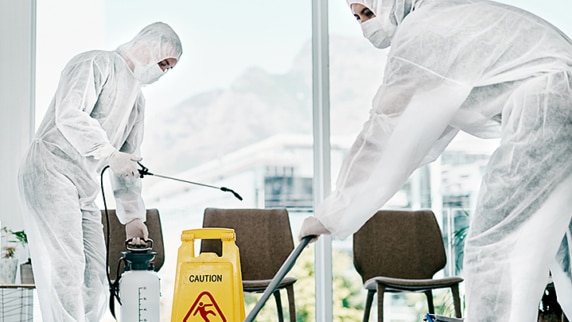
Our planning guide can be helpful as you look to reopen or expand operations. Remember to always adhere to federal, state, and local requirements, CDC guidelines, and recommendations of in-house counsel.
Due to the rapidly evolving nature of exposure, we recommend your organization create a COVID-19 task force with a designated leader for each location as well as an appointed individual for company oversight, assistance and guidance.
Reopening considerations
Operations
- Follow CDC, state, and local public health department guidelines for:
- Policy/procedure development and implementation on monitoring, testing and administration of COVID-19 issues with employees and patrons
- Occupancy and physical distancing requirements
- Cleaning, disinfecting, proper hygiene and personal protective measures
- CDC Guidance on “Opening America Up Again” and using gyms and fitness centers
- CAL/OSHA—California Department of Public Health fitness facility COVID-19 industry guidance
- When reopening buildings, work with maintenance to assess the operation of the HVAC and water systems, changing air filters, and flushing water systems. For additional information see our article on restarting equipment after business shut down.
- Post signage in key building locations to advise employees and patrons of the following:
- Not to enter if they feel sick
- Proper cough and sneeze etiquette
- Proper hand-washing hygiene
- Use of face coverings in accordance with state and local public health recommendations
- Identify, address, and modify/restrict areas where people tend to congregate including lobbies, locker rooms, areas with popular gym equipment, and exercise studios.
- Limit hours of operation to allow for proper facility cleaning and disinfection.
- Consider requiring online booking or monitoring the number of patrons for facility/equipment use, as well as fitness classes to adhere to occupancy guidelines and proper physical distancing.
- Discuss with your legal counsel the addition of a COVID-19 assumption of risk and waiver of liability clause in membership and facility use agreements.
- Keep websites and social media up to date with information including the right to refuse service to anyone exhibiting symptoms of COVID-19 and those who are not following appropriate social distancing guidelines.
- Evaluate the necessity of the use of saunas, whirlpools and equipment that could pose higher risk of airborne particles.
Employee safety
- Follow CDC guidelines for approved cleaning products and appropriate cleaning and disinfecting techniques.
- Increase staff or consider utilizing third-party cleaning vendors to assist with reopening, as well as ongoing increased cleaning demands.
- Equip staff with proper personal protective equipment (PPE) based on job tasks and follow state and local public health recommendations on the use of face coverings. Ensure all employees are trained on changes in increased cleaning and disinfecting protocols.
- Address employee wellness by providing frequent breaks and open communication channels.
- Follow CDC and state guidelines reminding employees who feel sick to stay home.
Patron safety
- Frequently clean all equipment with approved disinfecting solution, paying extra attention to high-touch areas (weights, treadmills, controls, balls, mats, handrails, switches, handles, etc.).
- Consider using a “ready to clean” sign after equipment use by guest to alert staff to clean and disinfect equipment in a timely manner.
- Prohibit sharing of equipment (sport specific, towels, athletic tape, wraps, etc.).
- Increase the frequency of cleaning and disinfection of the facility especially the high-touch areas, such as door handles, electronics, common areas, handrails, etc.
- Post and enforce guidelines and instructions regarding physical distancing and proper hygiene practices.
- Rearrange exercise equipment or restrict use to accommodate physical distancing protocols.
- Place hand sanitizers in convenient locations.
Restrooms, changing/locker rooms and showers
- Only allow shower and locker room use if partitions are in place or signs have been posted to specify physical distancing requirements. If partitions or proper distancing are not possible, these facilities should remain closed.
- Increase the frequency of cleaning and disinfection of high touch areas including faucets, toilets, doorknobs, handles and latches, as well as light switches.
- Consider requiring patrons to provide their own towels. If this is not possible and towels must be provided:
- Launder items according to the manufacturer’s instructions
- Use the warmest appropriate water setting and dry items completely
- Wear disposable gloves when handling used towels
- Do not shake used towels
- Clean and disinfect bins that hold used towels according to guidance for disinfecting surfaces
- Remove gloves, and wash hands right away after handling used towels
- Post signage in these areas to advise of the following:
- Proper cough and sneeze etiquette
- Proper hand-washing hygiene
- Use of face coverings in accordance with state and local public health recommendations
Juice/snack bars and food service safety
- Eliminate self-service food and beverage stations. Encourage use of bottled drinks.
- Snack bars and food service should be limited to pre-packaged and individually wrapped food when possible.
- Utilize plastic-wrapped utensils or individually napkin-wrapped silverware instead of self-service selection of utensils from boxes or baskets.
- For additional food service guidance see our article on restarting operations in the restaurant industry
Conclusion
It is important to communicate to employees about the steps you are taking to help keep them safe, and acknowledge the importance of the work they are doing. Capture and document your programs and efforts to keep everyone safe for future reference.
Your safety and well-being are our primary concern. These suggestions are general in nature, so please ensure that any activities you contemplate comply with all federal, state, and local COVID-19 orders impacting your facilities or operations as well as CDC guidelines for social distancing, hygiene, and other recommended best practices.
Our risk control services are advisory only. We assume no responsibility for: managing or controlling customer safety activities, implementing any recommended corrective measures, or identifying all potential hazards. No attempt has been made to interpret any referenced codes, standards, or regulations. Please refer to the appropriate government authority for interpretation or clarification.
Related insights
This website is general in nature, and is provided as a courtesy to you. Information is accurate to the best of Liberty Mutual’s knowledge, but companies and individuals should not rely on it to prevent and mitigate all risks as an explanation of coverage or benefits under an insurance policy. Consult your professional advisor regarding your particular facts and circumstance. By citing external authorities or linking to other websites, Liberty Mutual is not endorsing them.



